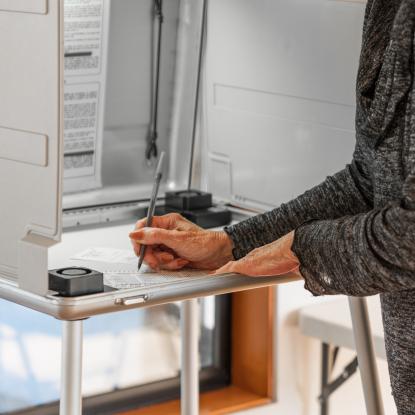Additional Resources


Ranked choice voting (RCV) makes our democracy more equitable and gives voters more choice at the ballot box.
RCV elections are more inclusive than the status quo (often called first-past-the-post elections) because the system gives voters an easy and more meaningful way to express their candidate preferences and make their voice heard.
What is ranked choice voting?
RCV is a process that allows voters to rank candidates for a particular office in order of preference. Consider a race where four candidates – A, B, C, and D – are running for a single seat such as Governor. In an election utilizing RCV, voters simply rank the candidates 1-4, with the candidate ranked as “1” being the voter’s highest preference for Governor. If a candidate is the first choice of more than half the voters, that candidate wins the election. But if no candidate gets the majority of the vote, the candidate with the least amount of support is eliminated, the second choice support for that eliminated candidate are redistributed, and this process continues until a candidate wins more than half of the vote.
For example, let’s say a voter prefers, in ranked order, candidate B, C, D, and then A. But, no candidate receives a majority of the votes in the first round, and candidate B receives the least first choice support. Candidate B is eliminated, and support for candidate B are distributed to the voter’s second choice, which in this case is candidate C. This process repeats until a candidate has a majority of the vote.
In multi-winner elections, such as city council races, the process is largely the same. The primary difference is that the threshold percentage of votes needed to win a seat is less than 50%, because more seats are up for election.
Ranked choice voting is currently used in more than 50 cities in 14 states -- including New York, NY, San Francisco, CA, Minneapolis, MN, Payson, UT, Cambridge, MA, Takoma Park, MD and Las Cruces, NM for various municipal elections. RCV is also used in Maine for U.S. House and Senate primary and general elections, and primaries for statewide offices and State Assembly seats. Alaskans approved RCV along with other democracy reforms when they approved Ballot Measure 2 in 2020, and used it for the first time in statewide elections in 2022.
Benefits of RCV
When voters are able to fully express their preferences, voter turnout also tends to increase. A study has shown that turnout in elections using RCV increased by ten percent, even after accounting for other factors.
RCV saves time and money for jurisdictions by eliminating the need for costly runoff elections. Runoff elections are not only costly but also less representative. Runoff elections tend to have low and unbalanced turnout resulting in the selection of candidates who may not actually reflect voter preferences.
With RCV, voters do not have to worry about strategically voting for candidates that they do not like in order to avoid “throwing away” or splitting their vote. If candidate B is the voter’s favorite choice, she can vote for B without fear that her vote will be “wasted.”
RCV forces candidates to abandon negative campaign tactics because candidates not only need the first choice support of their supporters, but also the second and third choice support from voters who prefer other candidates. A study has shown that jurisdictions with RCV have experienced friendlier campaigns and majority support in the cities using it.
Multi-winner RCV elections allow a larger spectrum of voters to elect their candidates of choice. In multi-winner RCV elections, minority communities and communities with a diversity of backgrounds can elect candidates of choice. This in turn can lead to a more diverse array of candidates.
Additional Resources